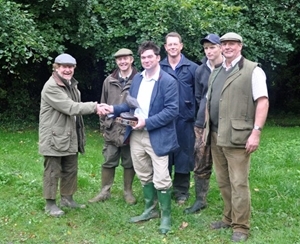 The Cranborne Estate in Dorset is the latest recipient of a prestigious conservation trophy awarded in recognition of the considerable efforts being made to boost one of our most threatened farmland birds, the wild grey partridge.
The Cranborne Estate in Dorset is the latest recipient of a prestigious conservation trophy awarded in recognition of the considerable efforts being made to boost one of our most threatened farmland birds, the wild grey partridge.
The trophy, which was presented to Lord Cranborne by Mike Swan, an advisor with the Game & Wildlife Conservation Trust (GWCT), is awarded each year by the Trust to the farm or estate in the Wessex region that has maximised conservation efforts for grey partridges as well as other declining farmland bird species.
Mike Swan, said, “We were delighted to present the trophy to Lord Cranborne at our autumn Wessex Grey Partridge Group meeting. The combined energy and enthusiasm of the Cranborne Estate team has made the estate a worthy winner of the grey partridge trophy.”
One of the aims of the Wessex Partridge Group, which attracts support from farmers and landowners across Wessex, is to share knowledge, experience and glean current advice on grey partridge conservation in an effort to boost the recovery of this once familiar farmland bird.
Over the past 40 years grey partridges have declined by nearly 86 per cent and the GWCT has been developing a raft of measures to kick-start a recovery programme across the country. Working closely with farmers and landowners has been an important factor in this recovery effort.
Mike Swan explains the importance of the latest meeting, “Visiting the Cranborne Estate was extremely instructive for all those attending the Wessex meeting. The fantastic teamwork between the owner, farm manager, gamekeepers and estate manager, has ensured that a programme of measures have been implemented around the estate to support grey partridges through their life-cycle. These include improved hedgerow management, grass margins, beetle banks and insect rich brood strips that provide food for foraging chicks. In addition, a generous winter and spring feeding programme is in place together with targeted predator control.”
Mike Swan explains, “As a result of these actions, grey partridges have increased from just a few pairs to a total of 34 pairs in 2012. However, when a population is so vulnerable, unforeseen events such as the appalling wet weather conditions last year can be a huge set-back in a recovery programme. As a consequence very few chicks survived last summer. But the outlook is much brighter following our good summer this year as more grey partridges were in evidence this autumn. The signs look excellent for continued population growth in the future. Another positive aspect of this conservation work is that other declining species like corn bunting, skylark and turtle dove are benefitting too.”
With winter approaching a key message from the day was that providing sources of over-winter cover and food across the farm is vital to help conserve important bird species through the leanest months of winter. Putting out feed hoppers is likely to ensure that more birds survive the winter and breed successfully next summer. As an added incentive to do this farmers and landowners are now being paid to provide additional grain during the ‘hungry gap’ (January to late April) through government funded agri-environment schemes.
More information on how to conserve wild grey partridges can be obtained from the Game & Wildlife Conservation Trust’s website at : www.gwct.org.uk/greypartridge.
END
Photocaption: Mike Swan (left) from the Game & Wildlife Conservation Trust presents Lord Cranborne with the GWCT’s Grey Partridge Trophy, which was awarded in recognition of the estate’s team effort to conserve grey partridges.
Notes to editors
The Game & Wildlife Conservation Trust – providing research-led conservation for a thriving countryside. The GWCT is an independent wildlife conservation charity which has carried out scientific research into Britain’s game and wildlife since the 1930s. We advise farmers and landowners on improving wildlife habitats. We employ more than 60 post-doctoral scientists and other research staff with expertise in areas such as birds, insects, mammals, farming, fish and statistics. We undertake our own research as well as projects funded by contract and grant-aid from government and private bodies.
For information, contact:
Eleanor Williams
Telephone: 07592 025476
Email: press@gwct.org.uk